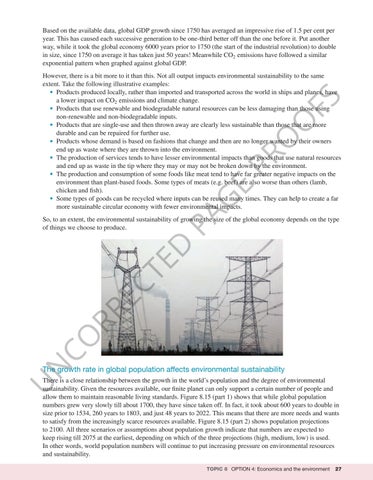“c08EconomicsAndTheEnvironment_PrintPDF” — 2022/6/6 — 17:03 — page 27 — #27
Based on the available data, global GDP growth since 1750 has averaged an impressive rise of 1.5 per cent per year. This has caused each successive generation to be one-third better off than the one before it. Put another way, while it took the global economy 6000 years prior to 1750 (the start of the industrial revolution) to double in size, since 1750 on average it has taken just 50 years! Meanwhile CO2 emissions have followed a similar exponential pattern when graphed against global GDP.
PA
G
E
PR
O
O
FS
However, there is a bit more to it than this. Not all output impacts environmental sustainability to the same extent. Take the following illustrative examples: • Products produced locally, rather than imported and transported across the world in ships and planes, have a lower impact on CO2 emissions and climate change. • Products that use renewable and biodegradable natural resources can be less damaging than those using non-renewable and non-biodegradable inputs. • Products that are single-use and then thrown away are clearly less sustainable than those that are more durable and can be repaired for further use. • Products whose demand is based on fashions that change and then are no longer wanted by their owners end up as waste where they are thrown into the environment. • The production of services tends to have lesser environmental impacts than goods that use natural resources and end up as waste in the tip where they may or may not be broken down by the environment. • The production and consumption of some foods like meat tend to have far greater negative impacts on the environment than plant-based foods. Some types of meats (e.g. beef) are also worse than others (lamb, chicken and fish). • Some types of goods can be recycled where inputs can be reused many times. They can help to create a far more sustainable circular economy with fewer environmental impacts.
N
CO RR EC
TE
D
So, to an extent, the environmental sustainability of growing the size of the global economy depends on the type of things we choose to produce.
The growth rate in global population affects environmental sustainability
U
There is a close relationship between the growth in the world’s population and the degree of environmental sustainability. Given the resources available, our finite planet can only support a certain number of people and allow them to maintain reasonable living standards. Figure 8.15 (part 1) shows that while global population numbers grew very slowly till about 1700, they have since taken off. In fact, it took about 600 years to double in size prior to 1534, 260 years to 1803, and just 48 years to 2022. This means that there are more needs and wants to satisfy from the increasingly scarce resources available. Figure 8.15 (part 2) shows population projections to 2100. All three scenarios or assumptions about population growth indicate that numbers are expected to keep rising till 2075 at the earliest, depending on which of the three projections (high, medium, low) is used. In other words, world population numbers will continue to put increasing pressure on environmental resources and sustainability. TOPIC 8 OPTION 4: Economics and the environment
27





















































